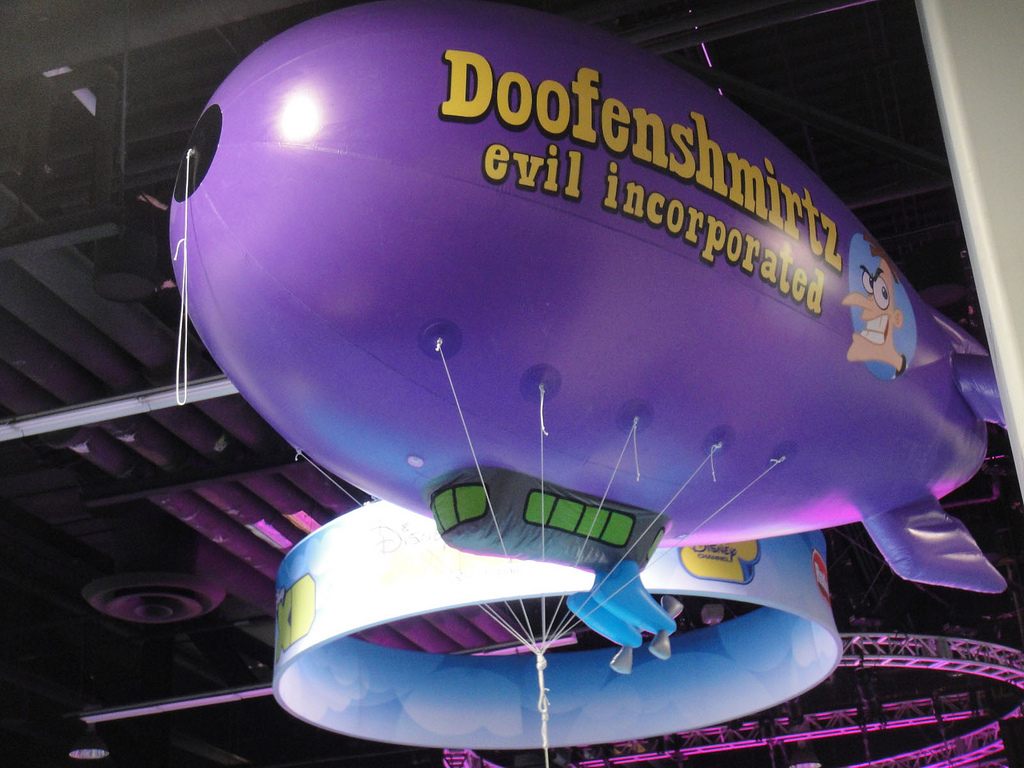Airships: The Most Villainous Form of Transport
From Colonel Blimp to Baron Bomburst, pop-culture bad guys sure love to cruise around in the sky.

Two hours into the 1985 James Bond classic A View to a Kill, antagonist Maximilian Zorin has already pulled out most of the bad-guy stops. He’s pushed one of his henchmen through a razor-sharp ventilation fan. He’s gunned down hundreds of his own employees with an Uzi. He’s plotted to flood Silicon Valley, killing millions and destroying the U.S. economy.
But as the plot crescendos and his plans fall to pieces around him, Zorin has one more trick up his sleeve. Sitting in what appears to be an ordinary shed, facing a control panel, he pushes a button marked “inflate,” and the whole room begins to rise off the ground. The camera pans out to show a giant airship, puffy and portentous and emblazoned with “Zorin Industries.” He’s a supervillain—of course he’s got a blimp.
Across decades, genres, and media—from Chitty Chitty Bang Bang’s Baron Bomburst to Batman’s Colonel Blimp —if you’ve got an over-the-top bad guy on the move, odds are good that he’s motoring along in an airship. By choosing to have their villains soar through the sky, writers, illustrators and designers aren’t just leaning on a stereotype. They’re choosing a powerfully inflated symbol, held aloft by decades of historical, aesthetic, and instinctive associations.
“The heart of this association lies in the first World War,” says Dr. Giles Camplin, airship historian and editor of the magazine Dirigible. During World War I, the Germany army outfitted Zeppelins with bombs and machine guns and sent them over Great Britain. Although they were supposed to target military sites, the pilots often got lost, and ended up bombing small villages.
“They were flying at night, and navigation was primitive in those days,” says Camplin. “There’s a lot of evidence that they simply threw their bombs out because the didn’t know where the heck they were.” Airship raids on Britain caused 557 deaths, and thousands more injuries.
For most people, this was a brand-new war horror. “Until the first World War, civilians were not involved,” says Camplin. “It was a thing that the professional soldiers did on the battlefield. And the dastardly Germans produced those Zeppelins, and then they just bombed civilians.”
Soon, the sight of an airship struck terror into the hearts of British citizens, who called them “baby-killers.” In a letter to a friend, poet D.H. Lawrence wrote that standing under an attack was akin to watching the birth of “a new order, a new heaven above us,” with the Zeppelin “having taken over the sky.” They were effective enough enemies that the government began putting them on recruitment posters.

In later decades, Nazis were easy cinematic villains, and films like Indiana Jones and the Last Crusade saw American heroes commandeering various German transport dirigibles in order to fight them. As other countries vaulted to the forefront of American villainy, they were afforded their own fictional fleets. Maximilian Zorin’s blond German countenance and collusion with the KGB allowed A View to a Kill to mine residual anti-German and burgeoning anti-Communist sentiment simultaneously, while Baron Bomburst hailed from a thinly disguised analogue of the formerly socialist Bulgaria, called Vulgaria.
Airships, literal gasbags that lack a crew, were fitting transport for the inflated aspirations of many of these villains.* Their buoyant frames, able to rock to and fro, be pierced or punctured, or deflate, afforded many possibilities for onscreen drama, especially post-war and post-Hindenberg, when they were already seen as inherently dangerous.
“You mention a modern airship, and the media brings up the Hindenberg, which everyone has seen crashing in flames,” says Camplin. This even though, as he points out, two-thirds of those involved in the Hindenburg accident survived, as opposed to other accidents like the Concorde which took the lives of all onboard. It’s unfair, he says: “If you’ve got a new ship, they don’t show pictures of the Titanic.”

If airships have been typecast, it helps that they often look the part. As with all once-new technologies, the airship has been through many incarnations on the way to its current form, giving designers a number of shapes to choose from. Camplin, who helped build Baron Bomburst’s pointy-ended airship for Chitty Chitty Bang Bang, says it was based on a real dirigible made by the Lebaudy Brothers. “The art director saw a picture, and he said ‘I must have that shape,’” remembers Camplin. The movie airship was plagued by steering problems—“we couldn’t get the damn thing to come down again,” he says—but its sinister appearance was just right.
Modern-day blimps are generally used for advertising, another visual association easily mined by supervillains, who are often obsessed with their own brands. Ratigan’s blimp, from 1986’s The Great Mouse Detective, is outfitted in the rodent’s signature purple and boasts a golden “R.” In the 2019 Blade Runner envisions, a blimp appears momentarily, trying to entice passerby into participating in its society’s plan for space domination: “A new life awaits you in the Off-World colonies. The chance to begin again in a golden land of opportunity and adventure. New climate, recreational facilities.....absolutely free.”

Dr. Heinz Doofenshmirtz, the over-the-top antagonist of popular animated TV show Phineas and Ferb, has an airship emblazoned with his company name, “Doofenshmirtz Evil Inc.” Every time it comes onscreen, a sunny jingle blares: “Doofenshmirtz Evil Dirigible!” This tendency has real-life analogues: Shady entrepreneur and boy-band-manager Lou Pearlman got his start at Ponzi-scheming with a fraudulent IPO for a business called Airship International which, as Billboard once noted, used the stock exchange ticker abbreviation “BLMP.”
Leaving aside these historical and current associations, a huge thing overhead is just unnerving, says Camplin, who remembers a hot air balloon safari he took in the 1970s. “The animals behaved really strangely,” he says. “They were frightened of this shape in the sky.” For mammals, a shadow passing overhead might mean a storm, or worse, a predator. Vervet monkeys even have a specific alarm call that means “here comes an eagle,” which spurs their peers to look straight up and then take cover.
When Camplin helped to pilot a large “flying sculpture” over the United States 15 years later, humans behaved similarly. “We went out without any pre-publicity,” he says. “And everybody went nuts because it looked like aliens were coming. It caused a huge sensation.” The response struck him as primal: “It’s going right back to the monkey heritage.”
Today, those like Camplin who see a bright future for the airship have to overcome all of these associations, both instinctual and learned. Airship enthusiasts believe the technology has the potential to transform everything from sea patrolling to low-fuel, long-distance transport—but when laypeople think of blimps and dirigibles, they usually picture them aflame, or looming scarily overhead, piloted by a movie rogue. “It’s really difficult, because when you start talking to people seriously about the future use of airships, you’ve got to unpack all that,” he says. “You’ve got a toxic brand.”
The sandbags of the past make it hard for good-guy blimps to get taken seriously. But some modern-day airships have bypassed public doubt by embracing their heritage—Hendrick’s Gin, for instance, flies a mean-looking blimp every summer, and Amazon recently won a patent for an “airborne fulfillment center,” filled with a warehouse’s worth of products and aided by thousands of “delivery drones.” As the future approaches, our airship overlords at the vanguard, it may be time for Lawrence’s “new order” after all.
*CORRECTION: We have edited a few terms in this story to clarify between blimps and dirigibles, and to reflect that airships are filled with gas, not hot air.










Follow us on Twitter to get the latest on the world's hidden wonders.
Like us on Facebook to get the latest on the world's hidden wonders.
Follow us on Twitter Like us on Facebook